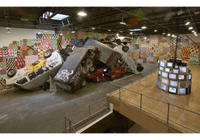Monday, August 22, 2005
Bottling Street Art’s Juice
 There’s always a tension that arises when the art establishment embraces a form of popular expression. Street art (when did it stop being “graffiti”?) serves as an interesting example.
There’s always a tension that arises when the art establishment embraces a form of popular expression. Street art (when did it stop being “graffiti”?) serves as an interesting example.The genre has its roots in non-commercial, rebellious expression. The interesting question here is how the gallery system can create value around an object that is typically given away, around a practice that is anarchic, and around an experience with the object that is by its nature transitory.
As it has gained credibility over the last two decades, street art has been brought into the commercial gallery environment in a variety of ways. Today, gallerists are trying to figure out how to distill the energy of street expression and package it for distribution. As an interesting case study, four different presentations of street art were on view within a block’s radius of each other in SoHo earlier this summer. Each of them bottled the work in a different manner.
Fresh Squeezed: While SoHo gallery spaces opened their doors to taggers this summer, the building across the street from Jeffrey Deitch’s Wooster Street space presents the real, unmediated thing 24x7x365. Completely covered with years of work in various states of decay, the façade of the building is a palimpsest of images and voices, giving the flavor of honest-to-goodness raw, unprocessed street art. (See a photo of the building here.)
 Filtered: In his Wooster Street space earlier this month, Jeffrey Deitch was showcasing the work of Barry McGee (installation view at right). McGee’s installations tried to capture the grit and decay of the urban landscape in a fun-house like environment. While McGee carried some of the feeling of the street into the gallery space, it felt like there was something missing in the presentation. Although it was plenty edgy and grimy, the installation felt just a little too safe. The sharp tang of the fresh squeezed (on view just across the street) had been filtered out.
Filtered: In his Wooster Street space earlier this month, Jeffrey Deitch was showcasing the work of Barry McGee (installation view at right). McGee’s installations tried to capture the grit and decay of the urban landscape in a fun-house like environment. While McGee carried some of the feeling of the street into the gallery space, it felt like there was something missing in the presentation. Although it was plenty edgy and grimy, the installation felt just a little too safe. The sharp tang of the fresh squeezed (on view just across the street) had been filtered out.Pasteurized: Around the corner on Grand Street, the Dactyl Foundation is presenting a group show (which runs into September) of work by members of the AKB Crew, a street collective that formed in Minneapolis-St. Paul in the late 1980s. Most members of the group have “gone straight” by now and are doing commercial art rather than tagging. (The group has gone so mainstream, in fact, that the AKB Crew’s website even has e-commerce capabilities.) This show highlights the results. Definitely street inspired, the show contains paintings, drawings, and collages that aspire to make the transition from the “folk art” of the street to the “fine art” of the gallery. The works retain some of the flavor of street art but none of the raw energy.
Synthetic: Down the block at his other location, Deitch was showing three installations by the street artist known as Swoon. In her work she used the gallery space to create environments reminiscent of the street, without attempting to bring the real thing into the gallery space. (The image at the top right of this post presents a section of one of her installations.) Strangely, though, as removed from the real as these installations were, they felt more right than any of the others. The environments created translated the essence of the street into the gallery environment in a way that was more satisfying that McGee's installations. The critics swooned over the show.
In the case of SoHo street art this summer, the simulacrum trumped the real, tasting better as it went down and making viewers thirsty for more. That doesn't happen too often in an artistic subculture that values authenticity and credibility, does it?